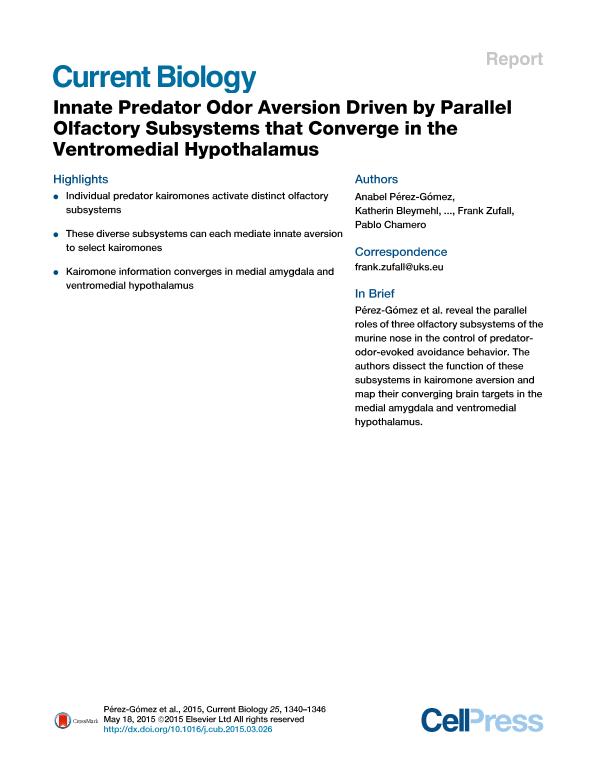Mostrar el registro sencillo del ítem
dc.contributor.author
Pérez Gómez, Anabel
dc.contributor.author
Bleymehl, Katherin
dc.contributor.author
Stein, Benjamin
dc.contributor.author
Pyrski, Martina
dc.contributor.author
Birnbaumer, Lutz

dc.contributor.author
Munger, Steven D.
dc.contributor.author
Leinders Zufall, Trese
dc.contributor.author
Zufall, Frank
dc.contributor.author
Chamero, Pablo
dc.date.available
2018-03-22T17:32:57Z
dc.date.issued
2015-05
dc.identifier.citation
Pérez Gómez, Anabel; Bleymehl, Katherin; Stein, Benjamin; Pyrski, Martina; Birnbaumer, Lutz; et al.; Innate predator odor aversion driven by parallel olfactory subsystems that converge in the ventromedial hypothalamus; Cell Press; Current Biology; 25; 10; 5-2015; 1340-1346
dc.identifier.issn
0960-9822
dc.identifier.uri
http://hdl.handle.net/11336/39686
dc.description.abstract
The existence of innate predator aversion evoked by predator-derived chemostimuli called kairomones offers a strong selective advantage for potential prey animals. However, it is unclear how chemically diverse kairomones can elicit similar avoidance behaviors. Using a combination of behavioral analyses and single-cell Ca2+ imaging in wild-type and gene-targeted mice, we show that innate predator-evoked avoidance is driven by parallel, non-redundant processing of volatile and nonvolatile kairomones through the activation of multiple olfactory subsystems including the Grueneberg ganglion, the vomeronasal organ, and chemosensory neurons within the main olfactory epithelium. Perturbation of chemosensory responses in specific subsystems through disruption of genes encoding key sensory transduction proteins (Cnga3, Gnao1) or by surgical axotomy abolished avoidance behaviors and/or cellular Ca2+ responses to different predator odors. Stimulation of these different subsystems resulted in the activation of widely distributed target regions in the olfactory bulb, as assessed by c-Fos expression. However, in each case, this c-Fos increase was observed within the same subnuclei of the medial amygdala and ventromedial hypothalamus, regions implicated in fear, anxiety, and defensive behaviors. Thus, the mammalian olfactory system has evolved multiple, parallel mechanisms for kairomone detection that converge in the brain to facilitate a common behavioral response. Our findings provide significant insights into the genetic substrates and circuit logic of predator-driven innate aversion and may serve as a valuable model for studying instinctive fear [1] and human emotional and panic disorders [2, 3].
dc.format
application/pdf
dc.language.iso
eng
dc.publisher
Cell Press

dc.rights
info:eu-repo/semantics/openAccess
dc.rights.uri
https://creativecommons.org/licenses/by-nc-sa/2.5/ar/
dc.subject
Odor Aversion
dc.subject.classification
Otras Ciencias Biológicas

dc.subject.classification
Ciencias Biológicas

dc.subject.classification
CIENCIAS NATURALES Y EXACTAS

dc.title
Innate predator odor aversion driven by parallel olfactory subsystems that converge in the ventromedial hypothalamus
dc.type
info:eu-repo/semantics/article
dc.type
info:ar-repo/semantics/artículo
dc.type
info:eu-repo/semantics/publishedVersion
dc.date.updated
2018-03-09T14:47:00Z
dc.journal.volume
25
dc.journal.number
10
dc.journal.pagination
1340-1346
dc.journal.pais
Estados Unidos

dc.description.fil
Fil: Pérez Gómez, Anabel. Universitat Saarland; Alemania
dc.description.fil
Fil: Bleymehl, Katherin. Universitat Saarland; Alemania
dc.description.fil
Fil: Stein, Benjamin. Universitat Saarland; Alemania
dc.description.fil
Fil: Pyrski, Martina. Universitat Saarland; Alemania
dc.description.fil
Fil: Birnbaumer, Lutz. National Institute of Environmental Health Sciences; Estados Unidos. Consejo Nacional de Investigaciones Científicas y Técnicas. Centro Científico Tecnológico Conicet - La Plata. Instituto de Investigaciones Biotecnológicas. Universidad Nacional de San Martín. Instituto de Investigaciones Biotecnológicas; Argentina
dc.description.fil
Fil: Munger, Steven D.. University of Florida; Estados Unidos
dc.description.fil
Fil: Leinders Zufall, Trese. Universitat Saarland; Alemania
dc.description.fil
Fil: Zufall, Frank. Universitat Saarland; Alemania
dc.description.fil
Fil: Chamero, Pablo. Universitat Saarland; Alemania
dc.journal.title
Current Biology

dc.relation.alternativeid
info:eu-repo/semantics/altIdentifier/doi/http://dx.doi.org/10.1016/j.cub.2015.03.026
dc.relation.alternativeid
info:eu-repo/semantics/altIdentifier/url/http://www.cell.com/current-biology/fulltext/S0960-9822(15)00341-3
dc.relation.alternativeid
info:eu-repo/semantics/altIdentifier/url/https://www.sciencedirect.com/science/article/pii/S0960982215003413
Archivos asociados
